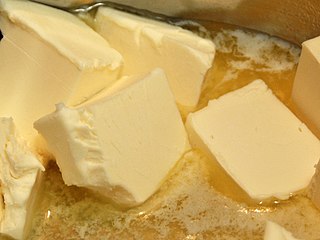
Butter is a dairy product made from the fat and protein components of churned cream. It is a semi-solid emulsion at room temperature, consisting of approximately 80% butterfat. It is used at room temperature as a spread, melted as a condiment, and used as a fat in baking, sauce-making, pan frying, and other cooking procedures.
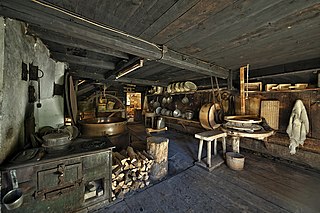
A dairy is a place where milk is stored and where butter, cheese and other dairy products are made, or a place where those products are sold. It may be a room, a building or a larger establishment. In the United States, the word may also describe a dairy farm or the part of a mixed farm dedicated to milk for human consumption, whether from cows, buffaloes, goats, sheep, horses or camels.

The Common Agricultural Policy (CAP) is the agricultural policy of the European Union. It implements a system of agricultural subsidies and other programmes. It was introduced in 1962 and has since then undergone several changes to reduce the EEC budget cost and consider rural development in its aims. It has however, been criticised on the grounds of its cost, its environmental, and humanitarian effects.
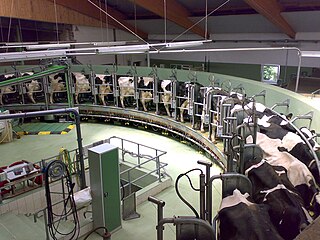
Dairy farming is a class of agriculture for the long-term production of milk, which is processed for the eventual sale of a dairy product. Dairy farming has a history that goes back to the early Neolithic era, around the seventh millennium BC, in many regions of Europe and Africa. Before the 20th century, milking was done by hand on small farms. Beginning in the early 20th century, milking was done in large scale dairy farms with innovations including rotary parlors, the milking pipeline, and automatic milking systems that were commercially developed in the early 1990s.

Raw milk or unpasteurized milk is milk that has not been pasteurized, a process of heating liquid foods to kill pathogens for safe consumption and extending the shelf life.
Agriculture and Agri-Food Canada is the department of the Government of Canada responsible for the federal regulation of agriculture, including policies governing the production, processing, and marketing of all farm, food, and agri-based products. Agriculture in Canada is a shared jurisdiction and the department works with the provinces and territories in the development and delivery of policies and programs.

A price floor is a government- or group-imposed price control or limit on how low a price can be charged for a product, good, commodity, or service. It is one type of price support; other types include supply regulation and guarantee government purchase price. A price floor must be higher than the equilibrium price in order to be effective. The equilibrium price, commonly called the "market price", is the price where economic forces such as supply and demand are balanced and in the absence of external influences the (equilibrium) values of economic variables will not change, often described as the point at which quantity demanded and quantity supplied are equal. Governments use price floors to keep certain prices from going too low.
Beatrice Foods Company was a major American food processing company founded in 1894. Over the years, Beatrice owned many well-known brands such as Tropicana, Dannon, Krispy Kreme, Jolly Rancher, Orville Redenbacher's, Swiss Miss, Peter Pan, Martha White, Playtex, La Choy, Samsonite and Avis Car Rental.

Government cheese is processed cheese provided to welfare beneficiaries, Food Stamp recipients, and the elderly receiving Social Security in the United States, as well as to food banks and churches. This processed cheese was used in military kitchens during World War II and has been used in schools since the 1950s.

The National Farmers Organization (NFO) is a producer movement founded in the United States in 1955, by farmers, especially younger farmers with mortgages, frustrated by too often receiving crop and produce prices that produced a living that paid less than the minimum wage, and, too often, might not even cover the cost of seed, fertilizer, land, etc. This was despite the many hours that might be devoted by an entire family. This was despite mortgages having to be paid in years of drought or hail or other crop failure. It was despite too high injury rates related to lifting and to high mortality rates due to working with heavy, sharp equipment. Frustrated farmers, thus, tried to obtain better prices. At first the methods included withholding of commodities from sale. The early methods also included opposition to those coops unwilling to withhold goods from market. During protests, farmers might purposely sell food directly to neighbors instead of through the co-ops. They might also destroy food in dramatic ways, in an attempt to gain media exposure, for example, slaughtering excess dairy cows. A 1964 incident brought negative attention when two members were crushed under the rear wheels of a cattle truck. They did not succeed in obtaining a Canadian-style quota system. Methods, thus, are different now.
Murray Goulburn Co-operative Co. Limited was a dairy-processing co-operative corporation. In 2018, following financial difficulties and difficulties with suppliers over sustainable prices, the business assets were sold to Saputo Inc, a publicly-listed Canadian dairy company and later the trading name of the business was changed to AG Warehouse. The co-operative was placed into liquidation in 2020.

The share of agriculture in Austria in the Austrian economy declined steadily after World War II, agriculture continues to represent an important element of the economy because of its social and political significance. The Chamber of Agriculture remains on an equal level with the chambers of commerce and labor, although its members produce only a fraction of the GDP that industrial and commercial workers produce.
In economics, a tariff-rate quota (TRQ) is a two-tiered tariff system that combines import quotas and tariffs to regulate import products.
The Market Sharing Quota (MSQ), In Canadian agricultural policy, is the federally-determined target for the amount of industrial milk to produce nationwide each year as part of its policy of supply management. It is determined by estimating the domestic demand for dairy products on a butterfat basis, adding about 3% to cover exports and subtracting the volume of approved imports.
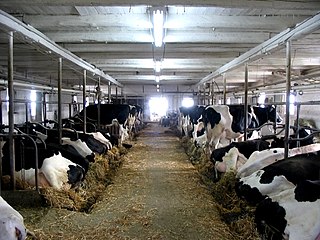
Dairy farming is one of the largest agricultural sectors in Canada. Dairy has a significant presence in all of the provinces and is one of the top two agricultural commodities in seven out of ten provinces.
Dairy Management Inc. is an American trade association funded primarily by the U.S. Dairy Promotion Program, itself funded by government-mandated checkoff fees on dairy products and federal tax dollars and dedicated to promoting the sale of American-made dairy products. It also operates under the names Innovation Center for U.S. Dairy, American Dairy Association, National Dairy Council and U.S. Dairy Export Council.
Dairy Farmers of Ontario (DFO), is the marketing organization and regulatory body representing over 4,000 dairy farmers in Ontario, Canada. DFO was formerly known as the Ontario Milk Marketing Board (OMMB), which was established as result of the 1965 Ontario Milk Act. On August 1, 1995, the Ontario Milk Marketing Board and the Ontario Cream Producers' Marketing Board merged to form Dairy Farmers of Ontario.

Canada's supply management, abbreviated SM, is a national agricultural policy framework used across the country, which controls the supply of dairy, poultry and eggs through production and import controls and pricing mechanisms. The supply management system was authorized by the 1972 Farm Products Agencies Act, which established the two national agencies that oversee the system. The Agriculture and Agri-Food Canada federal department is responsible for both the Canadian Dairy Commission and its analogue for eggs, chicken and turkey products, the Farm Products Council of Canada. Five national supply management organizations, the SM-5 Organizations — Egg Farmers of Canada (EFC), Turkey Farmers of Canada (TFC), Chicken Farmers of Canada (CFC), the Canadian Hatching Egg Producers (CHEP) and the Ottawa-based Canadian Dairy Commission (CDC), a Crown corporation — in collaboration with provincial and national governing agencies, organizations and committees, administer the supply management system.

Agriculture in Nova Scotia is the production of various food, feed, or fiber commodities to fulfill domestic and international human and animal sustenance needs. Nova Scotia is a province in Atlantic Canada totaling 55 284 km2 of land and water bordering New Brunswick. This province houses approximately 3795 farms averaging 262 acres per farm. The total land area used for farm lands in Nova Scotia is 995,943 acres.
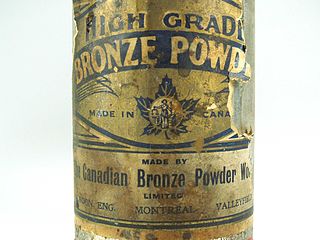
Made in Canada and Product of Canada are certification marks designating a claim that Canada is the country of origin of a good. A product label for that good may use these marks, or a qualified version, to present that claim to consumers. The certification marks are voluntary within Canada but may be required on exported goods, to comply with the laws of the country of export.












